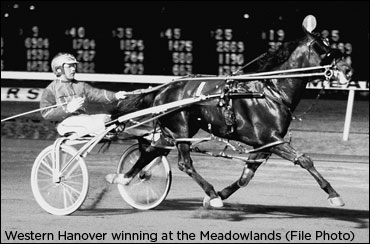This past December, Western Hanover reached a threshold that a minuscule number of horses ever attain. He is now the all-time money-producing sire of
all equine breeds. He passed the previous leader, Abercrombie, who had led the list for more than the last decade. Western Hanover is now the sire of the winners of $156,543,228 (U.S.).
Western Hanover’s story has often been told, but it is one that bears repeating.
A beautiful, but slightly diminutive yearling, he was nevertheless Hanover Shoe Farm’s highest priced yearling in its 1990 consignment. He was purchased for $105,000 by George Segal because his Hall of Fame trainer, Gene Riegle, had told him, “George, this is a colt you need to buy.”
Despite having respiratory problems in the winter, which delayed his debut until August, he virtually swept the table thereafter and was voted Two-Year-Old Pacing Colt of 1991, earning $697,322 (U.S.).
At three, Western Hanover again demonstrated the ability he had shown the previous campaign, as he became Three-Year-Old Pacing Colt of 1992, a season in which he earned $1,844,315 (U.S.).
 An interest in him was purchased by Hanover Shoe Farms, and he was slated to be syndicated and to enter the stud in 1993. The syndication process was difficult, and after virtually all of the leading market breeders had been offered the opportunity to buy shares in Western Hanover, only one, Allamerican Harnessbreds, did so.
An interest in him was purchased by Hanover Shoe Farms, and he was slated to be syndicated and to enter the stud in 1993. The syndication process was difficult, and after virtually all of the leading market breeders had been offered the opportunity to buy shares in Western Hanover, only one, Allamerican Harnessbreds, did so.
The reasons for this were probably twofold.
Firstly, he was entering the stud the same year as his stablemate and Horse of the Year, Artsplace. Artsplace was formidable competition and the large commercial breeders were more inclined to invest in him. Their investments were well made, as Artsplace met all expectations and almost immediately became one of the sport's epic sires.
The second, and perhaps just as important, reason was that some of the sport’s self-proclaimed experts began to refer to him with disdain as 'Little Ralph,' implying that they felt that he would become a disappointment in the stud, as had Ralph Hanover. This talk was especially prevalent after Western Hanover’s difficult Little Brown Jug loss.
Nevertheless, the small, but exclusive, syndicate went forward with him beginning his stud career in 1993 at Hanover Shoe Farms at a service fee of $4,000.
Aside from the support given him by his owners and the odd commercial breeders, his first book consisted mostly of 'mom and pop' mares.
From that first crop came the 1996 Metro Pace winner, Rustler Hanover, and the 1997 Triple Crown winner and Pacer of the Year, Western Dreamer.
It wasn’t really until his fifth crop that Western Hanover received the quality of broodmares that his previous success proved that he deserved. From that point forward, he ranked at or near the very top of all the world’s pacing sires.
Subsequently, virtually all of the harness world’s leading commercial breeders bought shares in him at a far higher price than for what he was originally syndicated. What was initially a disappointment for George Segal, ultimately turned into a windfall.
There’s no accurate way to predict how long Western Hanover will remain at the top of the list. However, with full crops of two and three-year-olds, in addition to a host of older pacers, it's fairly safe to predict that he should maintain his position for the better part of the next decade.
(Hanover Shoe Farms)

